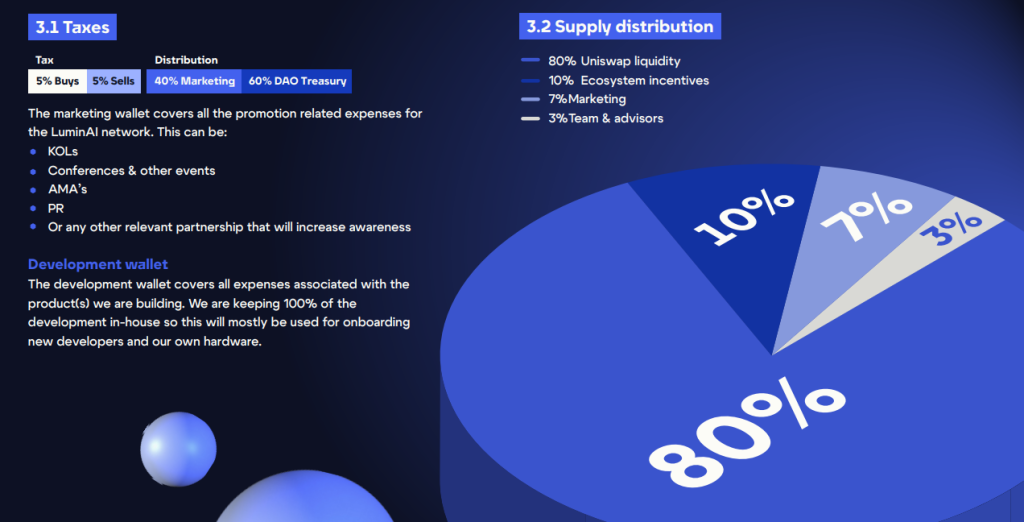At LuminAI, top-notch hardware is combined with state-of-the-art AI models to launch a decentralized platform designed to meet the diverse requirements of the AI community. This article provides a comprehensive overview of LuminAI, focusing on its innovative Mode-As-a-Service (MaaS) approach, key features, tokenomics, token utility, revenue sharing, and other essential aspects.
What is LuminAI?

LuminAI is a pioneering platform that brings together cutting-edge hardware and advanced AI models in a decentralized marketplace. By leveraging a network of nodes, LuminAI overcomes the limitations of centralized computational resources, offering scalability, transparency, and global accessibility. The platform enables individuals and organizations to rent GPU hardware and access the latest AI models, facilitating innovation and progress across various AI domains.
Mode-As-a-Service (MaaS)
One of the central elements of LuminAI is its proprietary Mode-As-a-Service (MaaS) approach. MaaS simplifies the integration of powerful graphics processing units (GPUs) into AI projects, whether for individual users or large organizations. This service model allows users to access high-performance hardware and the latest AI breakthroughs without significant upfront investment.
With MaaS, users can rent GPU power from reliable vendors or directly through the LuminAI platform. This flexibility ensures that users can select the best option based on their specific needs, preferences, and budgets. The MaaS model democratizes access to advanced computational resources, enabling users to drive AI innovation regardless of their location or resources.
Key Features of LuminAI
1. Decentralized Marketplace
LuminAI operates a decentralized marketplace that connects users with leading GPU hardware and superior AI models. This marketplace eliminates the drawbacks of traditional centralized platforms, such as geographical restrictions and vendor lock-in. By distributing computational resources across a network of nodes, LuminAI ensures scalability and reduces the risk of bottlenecks and resource shortages.
2. Integration with Open-Source Communities
LuminAI seamlessly integrates with major open-source AI communities, such as Hugging Face. This integration allows users to access the latest AI models and a wealth of knowledge accumulated within these communities. By leveraging open-source platforms, LuminAI users stay updated with the most current AI technologies and benefit from a collaborative culture of knowledge exchange.
3. Monetization Opportunities for GPU Owners
LuminAI offers a unique opportunity for GPU owners to monetize their hardware by renting it out to other users. This model enables GPU owners to earn passive income in cryptocurrency (ETH or $LUMAI tokens) while contributing to AI research and development. The platform’s secure and efficient transaction mechanism ensures smooth global transactions.
4. Pay-as-you-Go Model
LuminAI’s Pay-as-you-Go pricing model allows users to pay only for the GPU hours they use. This cost-efficient structure aligns with the dynamic requirements of AI projects, providing scalability and affordability. Users can adjust their computational resources based on their project needs, avoiding unnecessary costs and long-term contracts.
5. Global Accessibility
LuminAI is available in all major regions worldwide, ensuring that users from diverse backgrounds and locations can leverage its capabilities. This global reach enables individuals and organizations to access the latest AI infrastructure, fostering innovation and progress on a global scale.
6. Customization and Interoperability
LuminAI prioritizes compatibility and personalization, ensuring seamless integration with all Hugging Face models and other open-source AI solutions. Users can deploy their preferred AI models without encountering compatibility issues, streamlining the development and deployment process.
Tokenomics
LuminAI employs a well-structured tokenomics model to ensure the sustainable growth and development of the platform. The primary token used within the ecosystem is the $LUMAI token. The tokenomics model includes:

Token Utility
The $LUMAI token serves multiple purposes within the LuminAI ecosystem:
1. Payment for Services
Users can pay for GPU rentals and other services on the platform using $LUMAI tokens, providing a seamless and integrated payment solution.
2. Staking and Rewards
$LUMAI tokens can be staked to earn rewards, encouraging users to hold and invest in the platform. Stakers receive a share of the revenue generated from GPU rentals, promoting long-term engagement and participation.
3. Governance
Token holders have voting rights on key decisions regarding the platform’s development and future direction. This decentralized governance model ensures that the community has a voice in the evolution of LuminAI.
LuminAI employs a revenue-sharing model where a portion of the rental fees goes to the platform to cover operational costs and further development. The remaining revenue is distributed among $LUMAI token holders as rewards, based on snapshots. This incentivizes participation in the LuminAI economy and rewards users for their contributions.

Conclusion
LuminAI is at the forefront of revolutionizing the AI infrastructure industry, providing a decentralized platform that empowers users with advanced hardware and AI models. Through its innovative MaaS approach, seamless integration with open-source communities, and flexible pricing model, LuminAI offers a robust ecosystem for AI innovation. With a well-structured tokenomics model, diverse token utilities, and a revenue-sharing approach, LuminAI ensures sustainable growth and community involvement.



